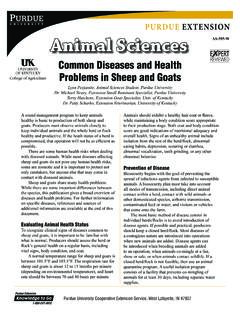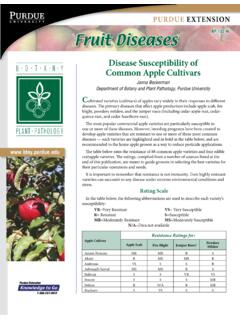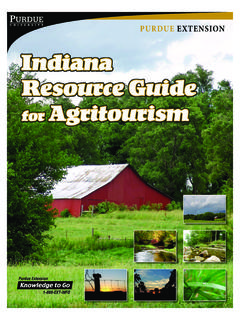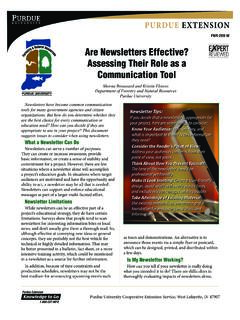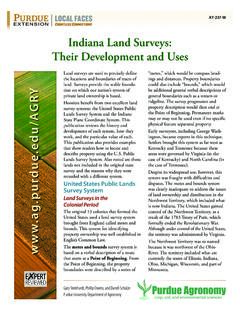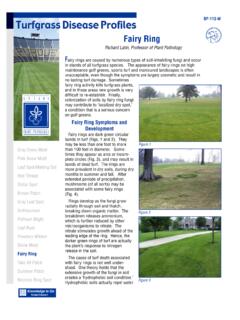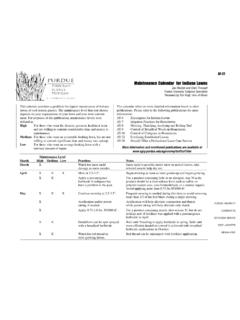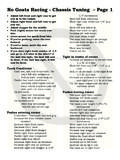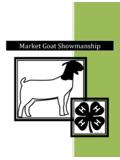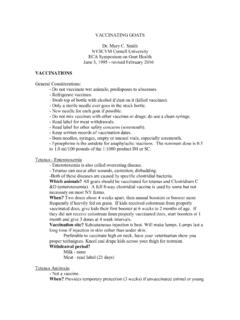Transcription of Managing Internal Parasitism in Sheep and Goats - …
1 Managing Internal Parasitism in Sheep and GoatsKate Hepworth, Animal Sciences Student; Mike Neary, Extension Sheep Specialist; Terry Hutchens, Extension Associate for goat Production, University of KentuckyP u r d u e e x t e n s i o nAS-573-WAnimal SciencesPurdue University Cooperative Extension Service, West Lafayette, IN 47907 Internal parasites are a significant threat facing today s small ruminant producer. Problems associated with parasites, particularly those of the gastrointestinal tract of Sheep and Goats can cause irreversible damage or even death to the animal, reduced performance and economic loss for the producer. Animals that are overburdened with parasites can be hindered in their reproductive performance, experience reduced growth rates, and become less productive overall, whether their purpose be meat, fiber, or milk. Prevention and control of the parasites that infect Sheep and Goats are becoming increasingly difficult due to generations of overuse and improper use of the available anthelmintic dewormers, which results in increasing resistance by parasites to common anthelmintics.
2 This paper will be used to give producers a general understanding of the parasites that affect their animals, how they live, and methods that can be used to lower their costs and losses due to parasite and Goats are affected for the most part by the same parasites. By far the most deadly Internal parasite to small ruminants in the Midwestern United States is the gastrointestinal roundworm Haemonchus contortus, also known as the barber pole worm and a variety of other names. Haemonchus contortus is a blood sucking parasite that can cause severe anemia, protein loss and death in Goats and Sheep , and thus is the most important to control. Some other parasites that affect Sheep and Goats are those of the Trichostrongylus family, particularly Teladorsagia circumcincta and Trichostrongylus axei, and the protozoa coccidia. Haemonchus contortus is the most dangerous parasite to Sheep and Goats in many parts of the United States, although other parasites may be important in different regions outside the Midwest.
3 However, by developing a parasite control plan aimed at Haemonchus, the majority of other dangerous parasites will be controlled as and Goats are generally affected by the same parasites, although certain parasites may affect one species more severely than the other, and treatment methods may vary between Sheep and Goats . In order to know how best to prevent future problems with parasites and control current infestations, it is necessary to understand the general life cycle of the parasites most common to Sheep and Goats . Figure 1: The lifecycle of a gastrointestinal parasite. This image is courtesy of Virginia Tech Cooperative Extension Knowledge to Go Haemonchus has a lifecycle that takes approximately 21 days to complete (see Figure 1). The cycle begins when the larvae in the infective L3 stage of development are ingested from the grass and travel to the abomasum, or true stomach, of the host. Once in the abomasum the larvae will follow one of two paths.
4 They may proceed with further larval stages and the eventual development into adults, or they will go into hypobiosis. This is an inhibited, or arrested development state, that occurs when conditions are not conducive for the entire life cycle to be the L3 stage larvae enter the abomasum, provided that environmental conditions are favorable, they will molt into the L4 stage of larval development and will then molt once more into adults. Factors that induce the molting of the L4 larvae into adults include: greening of grass, a rise in environmental temperature, rain following a drought period, increased estrogen levels in the host, and possible even a photoperiod stimuli. Once the molt into an adult form is complete adults then begin to lay eggs in the the case of Haemonchus and Ostertagia, the L4 larvae can go into arrested development, or hypobiosis. Hypobiosis is a period of dormancy that occurs when the environment is not conducive to the lifecycle of these parasites.
5 Larvae in different regions may go into hypobiosis in different times during the year, depending on the environment. For example, in the Midwestern states, Haemonchus larvae will likely become dormant during harsh winters. In southern parts of the country, hypobiosis may occur when the weather is too hot or dry for larvae to hypobiosis the L4 larvae hibernate in glands in the abomasum without developing further or causing problems for the host. They remain metabolically inactive until they receive signals that indicate it is time for them to resume development and then begin to lay eggs. The signals that spur the L4 larvae to come out of hypobiosis are the same signals mentioned above that indicate to them to develop in the first place. Once larvae leave hypobiosis, they resume the normal lifecycle and begin to lay adults require about 14 days to begin laying eggs (see Figure 2) in the stomach after reaching adulthood. The Haemonchus adult female can lay up to 5,000 eggs per day, yet another reason why Haemonchus is so difficult to control and so dangerous to Sheep and Goats .
6 Females that have gone through hypobiosis over the winter generally resume development two to four weeks prior to lambing or kidding and begin to produce eggs. This phenomenon is called the periparturient rise in fecal egg counts (will be discussed later). The eggs laid in the abomasum are expelled from the body via the in the feces generally remain inactive for a few days in the environment, until the environment and temperature become favorable for the development of these eggs into larvae. The larvae hatch from the egg and then emerge from the pellets and move through larval stages L1, L2 and L3 of development. Once the larvae reach the L3 stage, the infective stage, they emerge from the fecal pellet and climb up onto blades of grass (see Figure 3) where they wait to be ingested by a grazing animal, thus completing the lifecycle. In Figure : This image shows magnified eggs of Haemonchus Contortus. Figure 3: This image depicts larvae inside a droplet of water on a blade of Extension Knowledge to Go3order for the larvae to emerge from the fecal pellet in which it was expelled from the body, the environment has to be in a condition that keeps the pellet moist and pliable.
7 Optimal conditions for the L3 larvae to emerge from the pellet are warm, wet conditions, like those that usually occur in the early important characteristic of these larvae that must be taken into account when designing a parasite control plan is that the L3 larvae can survive on pasture for extended periods of time, making pasture management a key component in the prevention and control of parasite infection. The L3 larvae can survive on pasture for up to 90 days in the summer, and up to 180 days in the fall or winter. The Haemonchus larvae thrive in temperatures ranging from 70 to 80 Fahrenheit where there is an average of approximately 2 inches of rainfall per month. Extremely hot or dry environments will cause egg laying to stop, but the larvae can survive temperatures below 32 F. Ostertagia larvae prefer cooler temperatures, with their optimum temperature for development being around 40 Fahrenheit. These larvae are very resistant to adverse winter conditions, and can over-winter on SusceptibilityIndividual Goats and Sheep vary in their degree of susceptibility to Haemonchus and other parasites.
8 Some animals, by means of their genetics, are much more resistant or resilient to parasitic infections, and can survive parasite levels without showing any symptoms while another animal may be killed by that level of infestation. This genetic resistance can be used when selecting breeding stock, since a herd that exhibits more innate resistance to parasites will cost less to maintain and will ultimately be more profitable to the age and stage of development also have a significant impact on the susceptibility to parasites. As animals age, they are exposed to more and more parasites and develop some immunity to infection. This is more likely with Sheep than with Goats . Resistance describes an animal s ability to resist infection from parasites, while resilience describes the animal s ability to withstand infection from parasites once it has occurred. Young animals that are growing and are on continuous permanent pasture are the most susceptible to parasites.
9 These animals have very low levels of immunity, and are extremely susceptible to infection from parasites on pasture. They are also exposed to many eggs at a young age due to the periparturient egg rise of the ewe or doe. The lambs and kids will begin to develop some immunity to parasites around six to eight weeks of age, provided that they do not reach pathogenic levels of parasites in their system before this time. Lactating ewes and does on pasture follow the lambs and kids with slightly increased resistance to infection. Lactating animals are often in a negative energy balance, and therefore are weaker and less able to resist the effects of parasites on their body. Goats at any reproductive stage are more susceptible to parasitic infection than or does in late gestation, and for a short period after parturition lose much of their resistance to parasites due to hormonal and photoperiod effects. During this period, the ewe or doe is no longer able to resist worm development or egg production.
10 This phenomenon is termed the periparturient egg rise, and is a critical time in the parasite control plan. It is particularly important because it coincides with a time when the number of susceptible animals (kids or lambs) increases significantly. Finally, mature dry ewes are the least susceptible to parasitic infections. These animals have some immunity due to their age, and are under no real stress to their system that could lower their body s ability to resist parasitic infections. Goats of any age have little natural resistance or resilience to parasitic Parasitic InfectionsWhen animals are heavily burdened with parasites, there are a variety of symptoms that can be used to identify if an animal is infected with parasites, and which parasites are causing the problem. Some general symptoms typical of parasite infections are diarrhea, weight loss or reduced weight gain, unthriftiness, loss of appetite, and reduced reproductive capacity and performance.
